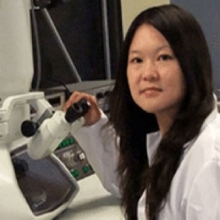ChEMS Seminar: Making Room at the Bottom with Advanced Scanning Transmission Electron Microscopy

Energy and Environment Directorate
Pacific Northwest National Laboratory, Richland, Wash.
Abstract: In his famous lecture in 1959, Richard Feynman stated, “It would be very easy to make an analysis of any complicated chemical substance, all one would have to do would be to LOOK AT it and see where the ATOMS are.” In this talk, I will show how we can leverage advanced scanning transmission electron microscopy (STEM) to accelerate the innovations in heterogeneous functional nanomaterials at the fundamental atomistic scale.
Modifying nanoscale materials by trace amounts of foreign elements represents an opportunity to extend their unique functionalities. Currently, much interest is devoted to the functional promotion of layered dichalcogenides, such as MoS2, for diverse applications in electronics, optoelectronics and heterogeneous catalysis. To rationally guide the promotional optimization, insight into the location and bonding geometry of the promoter elements is needed at the level of a single atom. I will show how we combine low-voltage and low-dose aberration-corrected STEM with electron energy loss spectroscopy (EELS) to enable the first single-atom sensitive spectroscopic analysis that unambiguously identifies single Co atoms in a promoted industrial-style MoS2 nanocatalyst in its native state. Furthermore, no material is completely static. To truly understand and guide materials design, dynamic behaviors of a functional material system need to be investigated in the presence of corresponding mechanical, electrical, chemical and/or thermal applied fields. Taking gas-solid reaction for instance, it is crucial to understand how the gas molecules affect the scattering of fast electrons contributing to an atomic scale image for better imaging sensitivity and resolvability in reaction-relevant gaseous environments. I will show how we evaluated the inelastic-noise-free annular dark-field STEM imaging mode for a directly interpretable observation under the influence of various gaseous environments at different pressure. Using this new environmental STEM (ESTEM), we unambiguously resolved all 13 cation atomic sites on the surface of a complex oxide catalyst (M1 catalyst) under the working condition. Combining in situ and big-data microscopy approaches, we revealed a new mechanism of generating catalytic active sites on the surface of a mixed-oxide catalyst (M1 catalyst) during oxidative ethane dehydrogenation. This realization opens new perspectives for tailoring nano-oxide functionalities.
Bio: Yuanyuan Zhu is currently a staff scientist at the Energy and Environment Directorate at Pacific Northwest National Laboratory. Starting with her master’s study at the prestigious Solid Atomic Imaging Division at the Institute of Metal Research, Chinese Academy of Science, she has over 10 years of electron microscopy experience. After receiving her Ph.D. in materials science and engineering from Texas A&M University, she worked at the R&D Division at Haldor Topsøe A/S, Demark, in collaboration with the National Center for Electron Microscopy at Lawrence Berkeley National Laboratory and Daresbury SuperSTEM, UK. She has a broad materials research background that includes experimental and theoretical investigation of mechanical properties of carbon/carbon composites, high-T superconductivity and flux-pinning enhancement, strain engineering of strongly correlated electronic heterosystems, chemical inhomogeneity in 2-D transition metal dichalcogenides, promoted catalysts and catalytic dynamics, and advanced analysis of defects in nuclear structural alloys. Currently, her research interests involve developing in situ and operando STEM for gas environmental atomic microscopy, diffraction contrast imaging (DCI-STEM) for dislocation characterization and deep-data electron microscopy.
Host: Daniel Mumm
Share
Upcoming Events
-
MSE Special Seminar: Architecting 3D Complex Materials for Sustainability
-
MSE Special Seminar: Decarbonizing Industries for a Climate-resilient Future - From Renewable Energy to Sustainable Material Recovery
-
MAE 298 SEMINAR: Technology Developments for FIR Bolometric Detector Focal Plane Assemblies
-
CBE 298 Seminar: The Wisdom of the Crowd: Watching Bacterial Collectives (Re)shape Themselves
-
CEE Seminar: BIM and the Digital Twin
